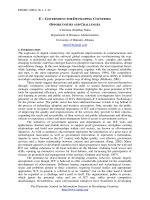Renewable energy technologies for developing countries phần 1 pdf
Bạn đang xem bản rút gọn của tài liệu. Xem và tải ngay bản đầy đủ của tài liệu tại đây (224.7 KB, 10 trang )
Renewable Energy
Technologies for
Developing Countries
Now and to 2023
By Dr. M. M. Qurashi
&
Engr. Tajammul Hussain
Publications of the Islamic Educational, Scientific and Cultural Organization
-ISESCO- 1426A.H./2005A.D.
CONTENTS
Foreword ……………………………………………………………
Chapter 1
Historical Background of Energy Consumption in the Past 50 Years
Chapter 2
The Case for Renewable Energy Sources …………………………
Chapter 3
The Changing Economics of Renewable Energy Technologies ……
Chapter 4
The Major Options for Various Categories of Countries …………
Chapter 5
Research, Development and Demonstration of Renewable-Energy
Technologies ………………………………………………………
Chapter 6
Some Other Likely Renewable Sources for Developing Countries
Chapter 7
Energy Policy and Planning ………………………………………
vii
1
9
25
45
53
71
81
Page
- v -
FOREWORD
Energy flows from many sources, exists in a variety of
interchangeable forms, and drives all systems. It is fundamental to the
quality of our lives and today, we find ourselves totally dependent on an
abundant and uninterrupted supply of energy for living and working. It is
undoubtedly the key ingredient in all sectors of modern economies.
Fossil fuels and nuclear technologies, as a core source of global
energy production since the beginning of the 1970’s, left behind a legacy
of thousands of thermal, natural gas and oil fired power plants spread
across the world. The carbon gas emissions and non-degradable nuclear
waste produced by these plants have caused serious environmental
problems such as the greenhouse effect leading to a virtual chain reaction
of ozone depletion followed by global warming and climate change.
Time and experience have shown that these energy production methods
are non-sustainable. Instead, hope for sustainable energy production is to
be found in renewable energy sources that are clean, cheap and ‘green’.
Renewable energy resources and technologies have the potential to
provide long-lasting solutions to the problems faced by the economic and
environmental sectors of a nation. Besides the overall global benefits,
renewable energy systems can provide direct benefits at national and
local levels, which justify their wide use in developing countries. They
can contribute to substantial savings in import bills for fossil fuels. At the
local level, availability of electricity contributes to improved
productivity, and indirect positive effects are also visible in the form of
the creation of new employment opportunities.
This book titled ‘Renewable Energy Technologies for Developing
Countries – Now and to 2023’, which is written by Dr. M.M. Qureshi and
Engr. Tajammul Hussain is a comprehensive document encapsulating the
need, importance, options and impact of renewable energy technologies
- vii -
in all spheres of economic and environmental livelihood. The authors
have been keen on establishing policy options and alternatives both on
the international and national arena. The thorough assessment of energy
options with specific reference to various developing countries is
especially commendable. The book is solid in terms of assessment,
comprehension and analysis of the current energy situation of the world
and provides logical and practical suggestions and recommendations for
the future world energy assessment and policy.
In a nutshell, the authors have earnestly put together a sound
document, which will serve as a reference for current and future policy
makers, giving them a lead in determining the strategic path to follow. I
sincerely believe that critical shapers of the economic milieu of our
Member States and other developing countries will benefit from the
deliberations of this book and hope that the various implementable
options enlisted in it will be given due and serious consideration.
Dr. Abdulaziz Othman Altwaijri
Director General
Islamic Educational, Scientific and
Cultural Organization -ISESCO-
- viii -
CHAPTER 1
HISTORICAL BACKGROUND OF ENERGY
CONSUMPTION IN THE PAST 50 YEARS
1. Energy as a Basis for Development
It is well-known today that technological and industrial progress is
heavily dependant on the readily availabile energy, the enormous
technological and industrial advancement of the socalled developed countries
was primarily made through exploitation of Earth’s vast reservoir of fossil
fuels. These fossil fuels, often imported from countries that themselves
lacked the science and technology required for their effective utilization,
helped the developed countries to attain affluence at an unprecedented pace.
It also helped to control the destinies of other less developed countries of
the world. The Industrial revolution developed the countries in two groups :
(i) Manufacturing Industrially Developed, (ii) Developing Countries with
raw material (Agarian economy). Today, Developed nations, with one
fifth of world’s population consume four-fifths of world’s fossil fuels.
In 1973, the oil-producing countries decided to increase the price of
crude oil by a factor of five from 2 dollars to 10 dollars per barrel. This
created a sensation and chaos in the economic situation of both the
developed and the non oil-producing developing countries. It was soon
realized that the indiscriminate and wasteful use of oil was no longer
acceptable and that concerted efforts had to be made for embarking upon
a programme of energy-conservation and urgent development of alternate
resources of energy. The economic development of most developing
countries has, since then, been greatly hampered by the ever-increasing
prices of oil, see Figure 1(a), which shows that, in 1960 the oil prices
were well below the cost-of living curve
1
(Qurashi, 1983), whereas they
1. M.M. Qurashi, “Sci. & Tech. in Islamic World”, 1, 1983, pp. 119-126.
- 2 -
were well above it in the late nineteen seventies, and still continue to rise,
although with some fluctuations from time to time substantial inputs of
Power are needed for nearly all industrial development. For the developing
countries generally, the effect of higher oil-prices has been to make it
difficult and, in some cases, nearly impossible to overcome power
shortages by importing cheap oil, as they did in the past. The real cost of
using oil by the developing countries is now many times higher in relation
to the use of possible substitutes than it was before. Where alternative fuels
exist, the change in relative costs is reflected in the prices of different fuels,
so that consumers are encouraged to switch over from the more expensive
to the cheaper ones. The changed pattern of energy-consumption is seen
clearly in the Logarithmatic plot shown in Fig. 1(b), which indicates zero
growth-rate of per-capita energy-consumption for the top segment of
developed countries.
2. Some Possible Alternative Strategies for
Developing countries during the ninetees
The growth of world’s per-capita energy-consumption from 1960 to
1985 / 1990 and thence projected on to 2020 A.D is shown in Figure 2,
while the detailed world energy projections are given in Figs. 3(a) & 3
(b). In the long term, the only real bottleneck preventing development is
Figure 1(a)
- 3 -
shortage of energy. For the immediate future, this means shortage of oil,
for which there is no substitute, and so various alternate strategies have to
be examined. The fact that industrialized countries, notably the US, are
the main oil importers, did place OPEC in a commanding position, at one
time. Although the level of demand is being affected by conservation and
substitution of other fuels in the industrialized and developing countries.
A picture of the World Energy-Consumption from 1995 - 2005 with
projection upto 2020 and required breakdown is shown in Fig. 4(a) & (b)
Source : A review of Energy Growth Pattern and conservation in Pakistan
Figure 1(b) : Logarithmic Plot for per capita energy-consumption (1984)
Figure 2 : Per-Capita Energy Consumption
- 4 -
Figure 3(a): World
Energy-Consumption, 1970-2020
Source : History : Energy Information
Administration (EIA), Office of Energy
Markets and End Use, International Statistics
Database and International Energy Annual
1999, DOE/EIA-0219(99) (Washington, DC,
January 2001). Projections: EIA, World
Energy Projection System (2001)
Figure 3(b): Projected Change in
Energy-Demand by Region, 1999-2020
Source : McGranaban and others, 2000;
Smith and Akbar, 1999
Figure 4(b): Environmental
Risk-Transition
Source : 1995-1999 : Energy Information
Administration (EIA), international Energy Annual
1999, DOE/EIA 02199(99) (Washington, DC,
January 2001), projections : EIA, World Energy
Projection System (2001)
Figure 4(a)
“World Energy Projection System”, 2001 E.I.A. Report (Figure 3(a&b)).
“World Energy Projection System”, 2001 E.I.A. Report (Figure 4(a&b)).
- 5 -
TWO MAIN STRAGEGIES : There have been two main strategies that
have been considered world-wide :
a) The first alternative, the so-called Hard Path, is based on (i) the
theory of ‘demand accommodation’ and demand will continue to increase
rapidly and continuously for many years – and (ii) that this ever-increasing
consumption of energy aggravates the problems of environmental pollution.
Obviously, as oil drops off, the use of coal-based synthetic fuels would
rise sharply. This is essentially a case of fuel switching or inter-fuel
substitution, involving the use of more readily available indigenous fuel
in place of (imported) oil. This would of course have to be coupled with
intensified exploration for oil.
b) The Soft Path : In contrast
2
, the other option – the ‘soft path’ –
involves radical change in energy options, at the earliest opportunity. It
has two aspects :
i) First, the consumption of non-renewable forms of energy should
not be allowed to grow, and should be actually reduced : this is the
‘conservation’ aspect and involves also the environmental aspect
of pollution (see Figure 4(b)).
ii) Secondly, as far as possible, there should be a shift in the
consumption of energy away from non-renewable sources, such as
coal, oil, gas, towards increasing use of renewables, i.e wind power,
tidal power, biogas, solar and geothermal energies. This shift has
to be of an appropriate magnitude that will fully take care of all
the increases in future consumption from non-renewable sources.
The total energy-consumption may still remain at the present levels
or may even continue to grow a little; but the gap should be filled by
other sources, namely nuclear power and renewable sources of energy. It
is anticipated that by 2100 A.D, renewable sources would contribute at
least 20% to 30% of the world energy-consumption. We may even be
optimistic and hope for a figure of 50% in some countries.
2. “World Energy Assessment : Energy and the challenges of Sustainbility”, 2000 UNDP
Report.
- 6 -
3. The Energy Transition (1980-95)
The challenge confronting the international community
3
is to achieve
an orderly and peaceful energy-transition from the present international
economy, based primarily on hydrocarbons, to one based increasingly on
new and renewable sources of energy. It has to be in a manner in which,
consistent with the needs and options of individual countries and is
socially equitable, economically and technically viable and is
environmentally sustainable. The transition must be based on technological,
commercial, financial and monetary modalities, consistent with the resolve
of various Governments to establish a new International Economic Order,
so as to accelerate the development of Third-World countries and to
promote balanced global development. An effective energy-transition
should conform with the principle of full and permanent sovereignty of
each country over its natural resources, and should be implemented in
accordance with its long-term national plans and priorities.
Primary Concept : The Primary Concept of Sustainable Development
is to : “Meet the needs of the present without compromising on the ability
of future generations to meet their own needs” (Our Common Future, the
World Commission on Environment and Development, 1987)
4. A Review of Energy Growth-Patterns and
Conservation since 1980 in Developing Countries
There are about 2 billion people (1/3rd of the world’s population) in
the Third World who lack access to adequate, affordable, clean and
convenient energy services. The index of distribution of wealth clearly
show that the richest of the world use 55% of final primary energy while
the poorest (20%) uses only 5 per cent. Exclusion from modern energy-
services is generally associated with poverty and environmental degradation.
The results of such comparisons show that by 1982, 72 per cent of
the drop in non-electric energy demand and 29.5 percent of the drop in
3. D.R. Pendse “The Energy Crisis and Third World Options in Third World Quarterly,
Vol.1, No.4, 1979, p. 82.









